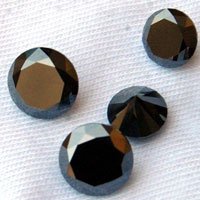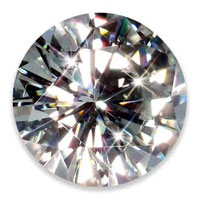There are actually several materials harder than sapphire but softer than diamond. One in particular, Silicon Carbide, is also a colored (from deep black through browns, reds, oranges, yellows, greens, blues, all the way to transparent colorless) and transparent gemstone that in its colorless, transparent form has 2.4 times the fire of a diamond.

Dispersion of Moissanite (left) compared to Diamond (right)
Moissanite, unlike Diamond, is birefringent
producing scintillating color flashes.
Sapphire rates a 9 on the Mohs relative hardness scale where diamond rates the highest at 10 when Frederich Mohs created his scale based on what minerals could scratch each other. There are now a few rare synthetic materials that are harder than natural diamond: Wurtzite —Boron Nitrite which is about 5% harder than diamond—and Lonsdaleite —aggregated hexagonal diamond nanotubes which are an amazing 10% harder than natural diamond— but so far, these have been created only in microscopic quantities.
Incidentally, Black Diamonds are slightly harder, and slightly lighter, than any other fancy colored diamond by a fractional percentage due to the enormous pressures of where it's thought they were all created in the center of a supernova.
Synthetic Silicon Carbide, called Moissanite in its pure colorless form which is sold in mid to high end jewelry, rates 9.4 on the Mohs scale. Other varieties of Silicon Carbide, depending on the impurities that give it the colors, can rate as low as 9.2, which still harder than Sapphire is also used in jewelry but in its darker opaque colors it's used as an abrasive.

Colors of gem Moissanite (Silicon Carbide)



Black Moissanite gems —— Green Moissanite gem —— White Mmoissannite gems
Silicon Carbide abrasives — sandblast grit and sandpaper.
American made gem quality transparent cut stones sell for as much as $6,000 for a 10 carat stone. . . I know because I bought one to put in a ring I had made for my girlfriend. ;^)
14.50mm, 10.34ct Forever Brilliant® Round Brilliant Charles & Colvard Created Moissanite Gemstone® $5,999.00—Charles & Colvard Created Moissanite
A diamond of that size, with less fire, would cost in the six if not seven figures. But, at those prices, I doubt it would be too economical to make iPhone screens out of Moissanite. LOL!
A Moissanite of equivalent diameter to a diamond weighs about 12% less so you may see them listed at "Diamond Equivalent Weight, or DEW, i.e. a 1 carat diamond would be the same size as a .89 carat Moissanite. The accepted practice in selling diamond stimulants of any kind, Moissanites included, is to list the .89 Carat Moissanite as a "1 carat DEW." In other words, it will look exactly the same size as a diamond of that carat size, regardless of how much it actually weighs. CZs are 1.6 times heavier than diamonds.
A black gem cut Moissanite can be bought on eBay for as low as $5.00 per carat. . . and industrial grade abrasive silicon carbide grit runs $7 to $32 per pound depending on grind. . . Or even less in 55 gallon drums.
Naturally occurring Silicon Carbide Moissanite is found in meteorites. . . and is extremely rare and valuable. The vast majority of Silicon Carbide is synthetic, made in electric furnaces.
Growing Moissanite in bolluses large enough for screens might not be feasible. But I've seen black Silicon Carbide cut round "Moissanite" gems as large as 2 1/4" across coming out of India. The Indian synthesizers haven't quite gotten the formula quite right yet to grow pure Moissanite, but they're getting better. I've seen some large (5 carat or so), gorgeous blue and green coming out of India. . . and a few similar just slightly cloudy white ones. These are probably around 9.3-9.35 on the Mohs scale. I bought a 4.7 carat Imperial Topaz color Indian Moissanite on eBay for just a little over $100 that is truly gorgeous. . . I'm going to mount it as a solitaire in Rose Gold for my girlfriend for her birthday. SHHHH! Don't tell her.